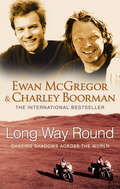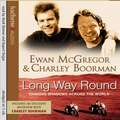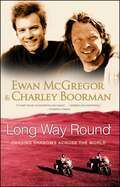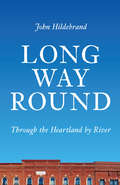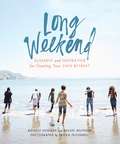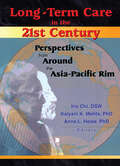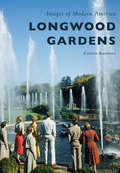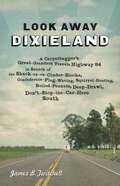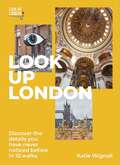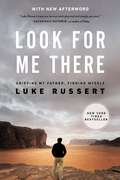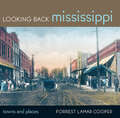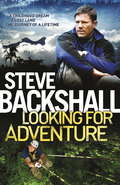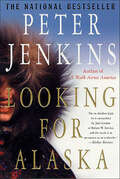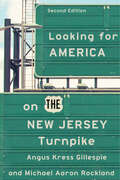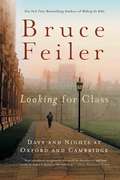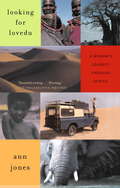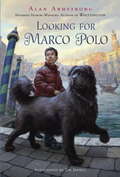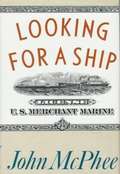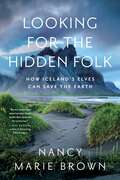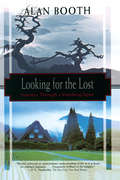- Table View
- List View
Long Way Round
by Charley Boorman Ewan McGregor'A highly readable and spiritually uplifting book about a dream come true' Wanderlust 'Touching and memorable ... one for armchair travellers and bike freaks' Daily MailFrom London to New York, Ewan and Charley chased their shadows through Europe, the Ukraine, Kazakhstan, Mongolia and Russia, across the Pacific to Alaska, then down through Canada and America. But as the miles slipped beneath the tyres of their big BMWs, their troubles started. Exhaustion, injury and accidents tested their strength. Treacherous roads, unpredictable weather and turbulent politics challenged their stamina. They were chased by paparazzi in Kazakhstan, courted by men with very large guns in the Ukraine, hassled by the police, and given bulls' testicles for supper by Mongolian nomads. And yet despite all these obstacles they managed to ride more than twenty thousand miles in four months, changing their lives forever in the process. As they travelled they documented their trip, taking photographs, and writing diaries by the campfire. Long Way Round is the result of their adventures - a fascinating, frank and highly entertaining travel book about two friends riding round the world together and, against all the odds, realising their dream.
Long Way Round
by Charley Boorman Ewan McGregor'A highly readable and spiritually uplifting book about a dream come true' Wanderlust 'Touching and memorable ... one for armchair travellers and bike freaks' Daily MailFrom London to New York, Ewan and Charley chased their shadows through Europe, the Ukraine, Kazakhstan, Mongolia and Russia, across the Pacific to Alaska, then down through Canada and America. But as the miles slipped beneath the tyres of their big BMWs, their troubles started. Exhaustion, injury and accidents tested their strength. Treacherous roads, unpredictable weather and turbulent politics challenged their stamina. They were chased by paparazzi in Kazakhstan, courted by men with very large guns in the Ukraine, hassled by the police, and given bulls' testicles for supper by Mongolian nomads. And yet despite all these obstacles they managed to ride more than twenty thousand miles in four months, changing their lives forever in the process. As they travelled they documented their trip, taking photographs, and writing diaries by the campfire. Long Way Round is the result of their adventures - a fascinating, frank and highly entertaining travel book about two friends riding round the world together and, against all the odds, realising their dream.
Long Way Round
by Charley Boorman Ewan McGregor'A highly readable and spiritually uplifting book about a dream come true' Wanderlust 'Touching and memorable ... one for armchair travellers and bike freaks' Daily MailFrom London to New York, Ewan and Charley chased their shadows through Europe, the Ukraine, Kazakhstan, Mongolia and Russia, across the Pacific to Alaska, then down through Canada and America. But as the miles slipped beneath the tyres of their big BMWs, their troubles started. Exhaustion, injury and accidents tested their strength. Treacherous roads, unpredictable weather and turbulent politics challenged their stamina. They were chased by paparazzi in Kazakhstan, courted by men with very large guns in the Ukraine, hassled by the police, and given bulls' testicles for supper by Mongolian nomads. And yet despite all these obstacles they managed to ride more than twenty thousand miles in four months, changing their lives forever in the process. As they travelled they documented their trip, taking photographs, and writing diaries by the campfire. Long Way Round is the result of their adventures - a fascinating, frank and highly entertaining travel book about two friends riding round the world together and, against all the odds, realising their dream.
Long Way Round: Chasing Shadows Across the World
by Charley Boorman Ewan McGregorIt started as a daydream. Poring over a map of the world at home one quiet Saturday afternoon, Ewan McGregor - actor and self-confessed bike nut - noticed that it was possible to ride all the way round the world, with just one short hop across the Bering Strait from Russia to Alaska. It was a revelation he couldn't get out of his head. So he picked up the phone and called Charley Boorman, his best friend, fellow actor and bike enthusiast. 'Charley,' he said. 'I think you ought to come over for dinner...' From London to New York, Ewan and Charley chased their shadows through Europe, the Ukraine, Kazakhstan, Mongolia and Russia, across the Pacific to Alaska, then down through Canada and America. But as the miles slipped beneath the tyres of their big BMWs, their troubles started. Exhaustion, injury and accidents tested their strength. Treacherous roads, unpredictable weather and turbulent politics challenged their stamina. They were chased by paparazzi in Kazakhstan, courted by men with very large guns in the Ukraine, hassled by the police, and given bulls' testicles for supper by Mongolian nomads. And yet despite all these obstacles they managed to ride over 20,000 miles in four months, changing their lives forever in the process. As they travelled they documented their trip, taking photographs, and writing diaries by the campfire. Long Way Round is the result of their adventures - a fascinating, frank and highly entertaining travel book about two friends riding round the world together and, against all the odds, realising their dream.
Long Way Round: Through the Heartland by River
by John HildebrandLong Way Round: Through the Heartland by River
Long Way Round: Through the Heartland by River
by John HildebrandInspired by tales of a mythic Round River, a circular stream where "what goes around comes around," John Hildebrand sets off to rediscover his home state. Wisconsin is in the midst of an identity crisis, torn by new political divisions and the old gulf between city and countryside. Cobbling rivers together, from the burly Mississippi to the slender wilds of Tyler Forks, Hildebrand navigates the beautiful but complicated territory of home. In once prosperous small towns, he discovers unsung heroes—lockmasters, river rats, hotelkeepers, mechanics, environmentalists, tribal leaders, and perennial mayors—struggling to keep their communities afloat. While history doesn't flow in a circle, it doesn't always move in a straight line either. Hildebrand charts the improbable ox-bows along its course. Long Way Round shows us the open road as a river with possibility around the next bend.
Long Weekend: Guidance and Inspiration for Creating Your Own Personal Retreat
by Rachel Neumann Richelle Sigele Donigan Ericka McConnellWith simple mindfulness activities, healthy recipes, and suggested itineraries to recharge, build community, and inspire creativity, this beautiful photo book is full of ideas that will inspire anyone seeking relaxation and reconnection. A great gift for all the busy people in your life.... and yourself.Here is your guide and inspiration for a weekend retreat to inspire renewal. Whether you sneak away with some friends or just turn off your devices and hide the to do list at home, Long Weekend is full of ideas to spend a creative, artistic, technology-free weekend filled with exercises and resources that will leave you feeling refreshed and rejuvenated. Includes basic itineraries for how to shape the time in addition to rituals of renewal provided by experienced retreat leaders Richelle Donigan and Rachel Neumann. Beautiful photographs by lifestyle photographer Ericka McConnell will transport you, so that reading the book feels like a retreat in itself. Great for armchair travelers as well as those looking for help planning a weekend away.
Long-Term Care in the 21st Century: Perspectives from Around the Asia-Pacific Rim
by Iris ChiWho pays for long-term care? Discover the unique approaches of seven countries around the Pacific Rim!Long-Term Care in the Twenty-First Century discusses policies and programs for long-term care in seven countries around the Asia-Pacific Rim: the United States, Canada, Japan, Australia, Singapore, Hong Kong, and Taiwan. Each country is covered in two chapters, one to examine the philosophy and values that underlie its approaches to long-term care, the second to discuss its systems of service delivery. These thoughtful analyses, backed up with facts and figures, explain program successes and failures in the context of demographic and social trends and with reference to the differing political systems across the region. Its breadth of perspective and insightful examination of cultural differences make Long-Term Care in the Twenty-First Century an important contribution to the international comparative study of aging. The programs in the United States, Australia, and Canada offer a fascinating contrast with the longer-established and very different programs in the Asian countries, including Japan, the world&’s oldest country.Long-Term Care in the Twenty-First Century provides practical information on essential gerontological issues for each country, including: financing arrangements development of client classification systems case management in both residential and community-based systems key source documents, references, and Web sites political and cultural influences home-based and family caregivingThis valuable book provides a critical record of developments in the current transition period. This multicultural perspective contributes a chance for all countries to learn from the experience of others in dealing with a problem that is increasingly important as the world population ages. Long-Term Care in the Twenty-First Century is an essential resource for scholars, service providers, policymakers, and anyone concerned with care of the aged, not only in Pacific Rim countries but around the world.
Longwood Gardens
by Colvin RandallThirty miles west of Philadelphia in the historic Brandywine Valley of southeastern Pennsylvania blooms Longwood Gardens, one of the world�s great horticultural centers. The original arboretum was planted beginning about 1800 by a Quaker family named Peirce. Industrialist Pierre Samuel du Pont (1870�1954) bought the property in 1906 to save its historic trees and make it a place where he could entertain his friends and the public. For three decades, he created an astounding collection of gardens, conservatories, and fountains and a perfect setting for the performing arts. Since du Pont�s death in 1954, Longwood Gardens has continued to evolve from a private estate to a very public garden, with renowned designers creating new landscapes to enhance the enjoyment of more than a million guests each year.
Look Away Dixieland: A Carpetbagger's Great-Grandson Travels Highway 84 in Search of the Shack-up-on-Cinder-Blocks, Confederate-Flag-Waving, Squirrel-Hunting, Boiled-Peanuts, Deep-Drawl, Don't-Stop-the-Car-Here South
by James B. TwitchellAs a boy, James Twitchell heard stories about his ancestors in Louisiana and even played with his great-grandfather's Civil War sword, but he never appreciated the state and the events that influenced a pivotal chapter in his family history. His great-grandfather, Marshall Harvey Twitchell, a carpetbagger from Vermont, had settled in upstate Louisiana during Reconstruction, married a local girl, and encountered much success until a fateful day in August 1874. The dramatic story of the elder Twitchell's life and near assassination fuels the author's pursuit of his family's history and a true understanding of the South.In Look Away, Dixieland, Vermont-native Twitchell sets out from his current home inFlorida on the inauguration day of America's first black president to find the "real" South and to try to understand the truth about his illustrious ancestor. He travels in an RV from Georgia's Okefenokee Swamp across Alabama and Mississippi to Coushatta, Louisiana. As he drives through the heart of Dixie, Twitchell sorts through the prejudices he learned from his northern rearing. In searching for the culture he had held at arm's length for so long, he tours small-town southern life -- in campgrounds, cotton gins, churches, country fairs, and squirrel dog kennels -- and uncovers some fundamental truths along the way. Notably, he discovers that prejudices of race, class, and ideology are not limited by geography. As one man from Georgia mockingly summed up North versus South stereotypes, "Y'all are rude and we're stupid."Unexpectedly, Twitchell also uncovers facts about his great-grandfather and sheds new light on his family's past. An enlightening, humorous, and refreshingly honest search, Look Away, Dixieland reveals some of the differences and similarities that ultimately define us as a nation.
Look Out, Washington, D.C.!
by Patricia Reilly Giff Blanche SimsWow! Washington, D.C.! Ms. Rooney's whole class gets to go on a two-day trip to the nation's capital. They'll see all kinds of great sights--the Washington Monument, the National Air and Space Museum, the zoo, and lots more.
Look Up London: Discover the details you have never noticed before in 10 walks
by Katie WignallA refreshing guide to discovering the hidden details of London with 10 fully guided walking routes from London's leading tour guide Look Up London. Have you ever noticed London's tiniest public sculpture? Or wondered why there are strange cone-shaped structures on the fanciest historic homes? Did you know that the Tower of London used to be a zoo, or about the now defunct London railway that transported over 200,000 people to their final resting place? These are just some of the fascinating details that Blue Badge Tourist guide Katie Wignall reveals in this absorbing guide to the secrets of London hidden in plain sight. Take a journey through London's rich past with these 10 fully guided walking routes and discover a whole world of incredible history hiding above your eye-line, just waiting to be spotted. From the saucy scandals of Covent Garden to stories of power and intrigue from the City, atmospheric pubs to hidden Roman remains, London is a city bursting with captivating stories which are etched into its very architecture. So, Look Up and discover a London you have never seen before.
Look Up London: Discover the details you have never noticed before in 10 walks
by Katie WignallA refreshing guide to discovering the hidden details of London with 10 fully guided walking routes from London's leading tour guide Look Up London. Have you ever noticed London's tiniest public sculpture? Or wondered why there are strange cone-shaped structures on the fanciest historic homes? Did you know that the Tower of London used to be a zoo, or about the now defunct London railway that transported over 200,000 people to their final resting place? These are just some of the fascinating details that Blue Badge Tourist guide Katie Wignall reveals in this absorbing guide to the secrets of London hidden in plain sight. Take a journey through London's rich past with these 10 fully guided walking routes and discover a whole world of incredible history hiding above your eye-line, just waiting to be spotted. From the saucy scandals of Covent Garden to stories of power and intrigue from the City, atmospheric pubs to hidden Roman remains, London is a city bursting with captivating stories which are etched into its very architecture. So, Look Up and discover a London you have never seen before.
Look for Me There: Grieving My Father, Finding Myself
by Luke RussertINSTANT NEW YORK TIMES BESTSELLERIn Look for Me There, Luke Russert traverses terrain both physical and deeply personal. On his journey to some of the world&’s most stunning destinations, he visits the internal places of grief, family, faith, ambition, and purpose—with intense self-reflection, honesty, and courage."—Savannah Guthrie, coanchor of Today&“Look for me there,&” news legend Tim Russert would tell his son, Luke, when confirming a pickup spot at an airport, sporting event, or rock concert. After Tim died unexpectedly, Luke kept looking for his father, following in Tim&’s footsteps and carving out a highly successful career at NBC News. After eight years covering politics on television, Luke realized he had no good answer as to why he was chasing his father&’s legacy. As the son of two accomplished parents—his mother is journalist Maureen Orth of Vanity Fair—Luke felt the pressure of high expectations but suddenly decided to leave the familiar path behind.Instead, Luke set out on his own to find answers. What began as several open-ended months of travel to decompress and reassess morphed into a three-plus-year odyssey across six continents to discover the world and, ultimately, to find himself.Chronicling the important lessons and historical understandings Luke discovered from his travels, Look for Me There is both the vivid narrative of that journey and the emotional story of a young man taking charge of his life, reexamining his relationship with his parents, and finally grieving his larger-than-life father, who died too young. For anyone uncertain about the direction of their life or unsure of how to move forward after a loss, Look for Me There is a poignant reflection that offers encouragement to examine our choices, take risks, and discover our truest selves.
Looking Back Mississippi: Towns and Places
by Forrest Lamar CooperFor the past three decades, historian and archivist Forrest Lamar Cooper has written a regular column for Mississippi Magazine about unusual, fascinating aspects of the state's history, culture, products, and people. Whether describing the Jubilee Beverage Company of Jackson, the origins of the Mississippi State Fair, a Mississippi veteran who fought at Iwo Jima, or Biloxi's Riviera Hotel, Cooper's “Looking Back” columns are thoroughly researched and written with verve and clarity. Looking Back Mississippi: Towns and Places collects thirty-nine of Cooper's best essays on the various cities, towns, dwellings, parks, and institutions of historical resonance. Covering all corners of the state, from the mid-1800s to the 1930s, the volume offers an engaging, convivial alternative history of Mississippi, one that emphasizes the obscure and small-scale over the big picture. Each short essay is accompanied by photographic and illustrative postcards from Cooper's private collection. These postcards and other memorabilia give delightful visual clarity to Cooper's historical accounts of towns as far north as Hernando and as coastal as Pass Christian, from the Delta to the Pine Belt. Cooper focuses on Mississippi places, and the people and events that made them famous. Much of the architecture and even the terrain—as with the Gulf Coast's once legendary orange groves—has disappeared, making Cooper's postcards invaluable resources for understanding and visualizing what no longer exists. Looking Back Mississippi provides a treasure trove of history and insight into long-vanished corners of the state.
Looking For Adventure
by Steve BackshallHow do you become an explorer? It's a question every child has asked. And, Steve Backshall was no different. But after a rainy-day visit to an exhibition of artefacts from Papua New Guinea, it was a question that began to obsess the seven-year old Backshall. Due to this childhood interest, the vast, untamed wildness of Papua New Guinea was where Backshall forged his unlikely path. From crushing lows of early failures to the extraordinary highs of the BBC's Lost Land of the Volcano expedition, it was this dark island which gave Backshall his opportunity. Full of incredible wildlife, extraordinary wilderness, jungles, cannibals, pitfalls, triumph, danger and excitement, Looking for Adventure is the irresistible, inspiring story of a little boy who let his heart rule his head.
Looking for Adventure
by Steve BackshallA Childhood Dream. A Lost Land. The Journey of a Lifetime.How do you become an explorer? It's a question every child has asked. And, Steve Backshall was no different. But after a rainy-day visit to an exhibition of artefacts from Papua New Guinea, it was a question that began to obsess the seven-year old Backshall. Due to this childhood interest, the vast, untamed wildness of Papua New Guinea was where Backshall forged his unlikely path. From crushing lows of early failures to the extraordinary highs of the BBC's Lost Land of the Volcano expedition, it was this dark island which gave Backshall his opportunity. Full of incredible wildlife, extraordinary wilderness, jungles, cannibals, pitfalls, triumph, danger and excitement, Looking for Adventure is the irresistible, inspiring story of a little boy who let his heart rule his head.
Looking for Alaska
by Peter JenkinsMore than twenty years ago, a disillusioned college graduate named Peter Jenkins set out with his dog Cooper to look for himself and his nation. His memoir of what he found, A Walk Across America, captured the hearts of millions of Americans.Now, Peter is a bit older, married with a family, and his journeys are different than they were. Perhaps he is looking for adventure, perhaps inspiration, perhaps new communities, perhaps unspoiled land. Certainly, he found all of this and more in Alaska, America's last wilderness.Looking for Alaska is Peter's account of eighteen months spent traveling over twenty thousand miles in tiny bush planes, on snow machines and snowshoes, in fishing boats and kayaks, on the Alaska Marine Highway and the Haul Road, searching for what defines Alaska. Hearing the amazing stories of many real Alaskans--from Barrow to Craig, Seward to Deering, and everywhere in between--Peter gets to know this place in the way that only he can. His resulting portrait is a rare and unforgettable depiction of a dangerous and beautiful land and all the people that call it home. He also took his wife and eight-year-old daughter with him, settling into a "home base" in Seward on the Kenai Peninsula, coming and going from there, and hosting the rest of their family for extended visits. The way his family lived, how they made Alaska their home and even participated in Peter's explorations, is as much a part of this story as Peter's own travels.All in all, Jenkins delivers a warm, funny, awe-inspiring, and memorable diary of discovery-both of this place that captures all of our imaginations, and of himself, all over again.
Looking for America on the New Jersey Turnpike, Second Edition
by Michael Aaron Rockland Angus Kress GillespieA twelve-lane behemoth cutting through the least scenic parts of the Garden State, the New Jersey Turnpike may lack the romantic allure of highways like Route 66, but it might just be a more accurate symbol of American life, representing the nation at both its best and its worst. When Angus Gillespie and Michael Rockland wrote Looking for America on the New Jersey Turnpike in 1989, they simply wanted to express their fascination with a road that many commuters regarded with annoyance or indifference. Little did they expect that it would be hailed as a classic, listed by the state library alongside works by Whitman and Fitzgerald as one of the ten best books ever written about New Jersey or by a New Jerseyan. Now Looking for America on the New Jersey Turnpike is back in a special updated and expanded edition, examining how this great American motorway has changed over the past thirty-five years. You’ll learn how the turnpike has become an icon inspiring singers and poets. And you’ll meet the many people it has affected, including the homeowners displaced by its construction, the highway patrol and toll-takers who work on it, and the drivers who speed down its lanes every day.
Looking for Class
by Bruce FeilerAn irresistible, entertaining peek into the privileged realm of Wordsworth and Wodehouse, Chelsea Clinton and Hugh Grant, Looking for Class offers a hilarious account of one man's year at Oxford and Cambridge -- the garden parties and formal balls, the high-minded debates and drinking Olympics. From rowing in an exclusive regatta to learning lessons in love from a Rhodes Scholar, Bruce Feiler's enlightening, eye-popping adventure will forever change your view of the British upper class, a world romanticized but rarely seen.
Looking for Lovedu
by Ann JonesThe acclaimed adventure writer Ann Jones tells the story of her overland journey, with the British photographer Kevin Muggleton, from one end of Africa to the other. Their purpose: to reach the southernmost tip of the continent and find the Lovedu people, a legendary tribe guided by the "feminine" principles of compromise, tolerance, generosity, and peace. A tribe that was known for its use of skillful diplomacy instead of warfare, and was ruled by a wise and powerful magician, a great rainmaking queen--the inspiration for H. Rider Haggard's novel She.Together Jones and Muggleton set out from England in a 1980 powder-blue army surplus Series III Land Rover. They hurry through France and Spain to Gibraltar and board an intercontinental ferry to North Africa. In Morocco they work a scam to circumvent government red tape, and travel on toward the first great challenge of the journey: the Sahara, where, despite dire warnings, they set out alone, through roadless shifting dunes, across the great apricot-colored expanse of desert.Jones tells how they ferry across the river into Senegal and come upon the Île de Saint-Louis, the first French settlement in West Africa. She describes how they beat their way through trackless bush to Bamako, the capital of Mali, on the Niger River, as their vehicle begins to disintegrate, and how they speed southward through once-prosperous Côte d'Ivoire and pause to visit the full-scale replica of Rome's Saint Peter's Basilica, built by the then-president of Côte d'Ivoire at a cost of 360 million of his own dollars. In Ghana they explore a fort from which slaves were shipped to the New World. They hurry through Togo and Benin to Nigeria, where they are harassed by omnipresent soldiers in the uneasy aftermath of the execution of the author Ken Saro-Wiwa and other political dissidents. In Cameroon they meet the fon of Chobe and his chief female minister, Ya Wende, and visit the twenty-four wives of the fon of Nkwem.As they continue the journey they battle malaria, try to reform two would-be robbers, sing Christmas carols with American missionaries, confront extornionist and dangerous Mobutu men, and come near collapse on Zaire's impassable muddy "roads." Finally, they pause to recuperate in a posh hotel, whose luxuries spell the end of their expedition together--the author rejecting modern comforts, her companion yearning for more.Ann Jones writes of how she travels on in search of the Lovedu people: through Tanzania and Malawi and the Tete Corridor of Mozambique to the ruins of the once-magnificent city of Great Zimbabwe. She writes of crossing the Limpopo River into South Africa, where her long journey culminates in an audience with Modjadji V, Queen of the Lovedu.Her book is an irrestistible roller-coaster ride through Africa--crowded with obstacles, beauty, maddening corruption, and marvelous people.From the Hardcover edition.
Looking for Marco Polo
by Alan ArmstrongNewbery Honor-winning author Alan Armstrong's latest book! Eleven-year-old Mark's anthropologist father has disappeared in the Gobi desert while tracing Marco Polo's ancient route from Venice to China. His mother decides they must go to Venice to petition the agency that sent Mark's father to send out a search party. Anxious about his father and upset about spending Christmas away from home, Mark gets a bad asthma attack in the middle of the night. That's when Doc Hornaday, an old friend of Mark's father, makes a house call, along with a massive black Tibetan mastiff called Boss. To distract Mark from his wheezing and to pass the long Venetian night, the Doc starts to spin for Mark the tale of Marco Polo. Doc describes Marco's travels and the boy finds himself falling under the spell of the story that has transfixed the world for centuries. Marco's journey bolsters Mark's courage and whets his appetite for risk and adventure, and for exposure to life in all its immense and fascinating variety. From the Hardcover edition.
Looking for a Ship
by John McpheeThis is an extraordinary tale of life on the high seas aboard one of the last American merchant ships, the S. S. Stella Lykes, on a forty-two-day journey from Charleston down the Pacific coast of South America. With his usual interest in everything and everybody, John McPhee tells a wide-ranging story of the U.S. Merchant Marine, the ships that are a part of it, and the people who work the ships, the history and geology of the places he sees, sea tales, pirates, and the amazing variety of products that are carried by freighters.
Looking for the Hidden Folk: How Iceland's Elves Can Save the Earth
by Nancy Marie BrownIn exploring how Icelanders interact with nature—and their idea that elves live among us—Nancy Marie Brown shows us how altering our perceptions of the environment can be a crucial first step toward saving it.Icelanders believe in elves. Why does that make you laugh?, asks Nancy Marie Brown in this wonderfully quirky exploration of our interaction with nature. Looking for answers in history, science, religion, and art—from ancient times to today—Brown finds that each discipline defines what is real and unreal, natural and supernatural, demonstrated and theoretical, alive and inert. Each has its own way of perceiving and valuing the world around us. And each discipline can be defined, in the Icelandic perception, by its own sort of elf. Illuminated by her own encounters with Iceland&’s Otherworld—in ancient lava fields, on a holy mountain, beside a glacier or an erupting volcano, crossing the cold desert at the island&’s heart on horseback—Looking for the Hidden Folk offers an intimate conversation about how we look at and find value in nature. It reveals how the words we use and the stories we tell shape the world we see. It argues that our beliefs about the Earth will preserve—or destroy it. Scientists name our time the Anthropocene: the Human Age. Climate change will lead to the mass extinction of numerous animal species unless we humans change our course. Iceland suggests a different way of thinking about the Earth, one that offers hope. Icelanders believe in elves— and you should, too.
Looking for the Lost: Journeys Through a Vanishing Japan
by Alan BoothA VIBRANT, MEDITATIVE WALK IN SEARCH OF THE SOUL OF JAPAN Traveling by foot through mountains and villages, Alan Booth found a Japan far removed from the stereotypes familiar to Westerners. Whether retracing the footsteps of ancient warriors or detailing the encroachments of suburban sprawl, he unerringly finds the telling detail, the unexpected transformation, the everyday drama that brings this remote world to life on the page. Looking for the Lost is full of personalities, from friendly gangsters to mischievous children to the author himself, an expatriate who found in Japan both his true home and dogged exile. Wry, witty, sometimes angry, always eloquent, Booth is a uniquely perceptive guide. Looking for the Lost is a technicolor journey into the heart of a nation. Perhaps even more significant, it is the self-portrait of one man, Alan Booth, exquisitely painted in the twilight of his own life.
